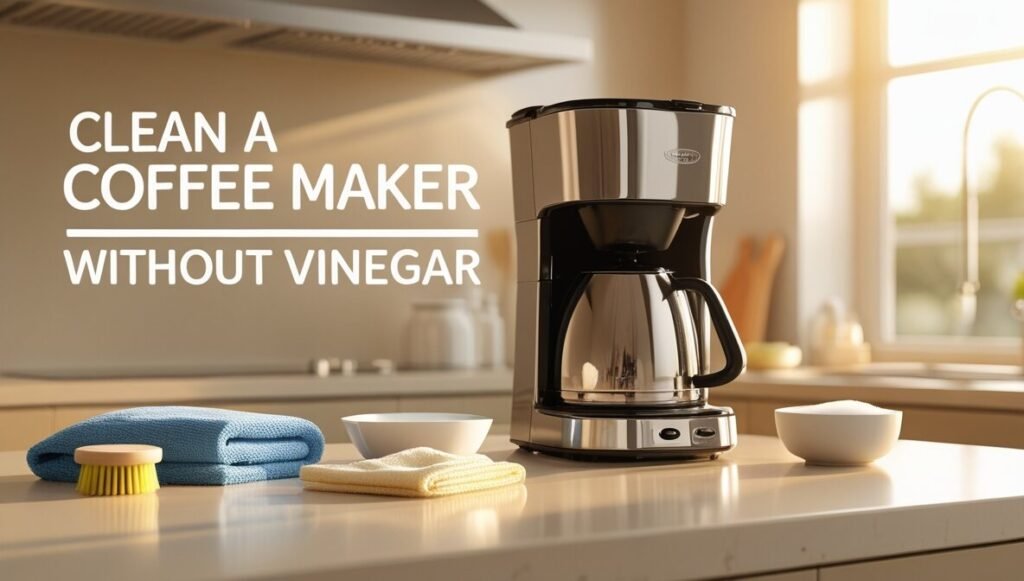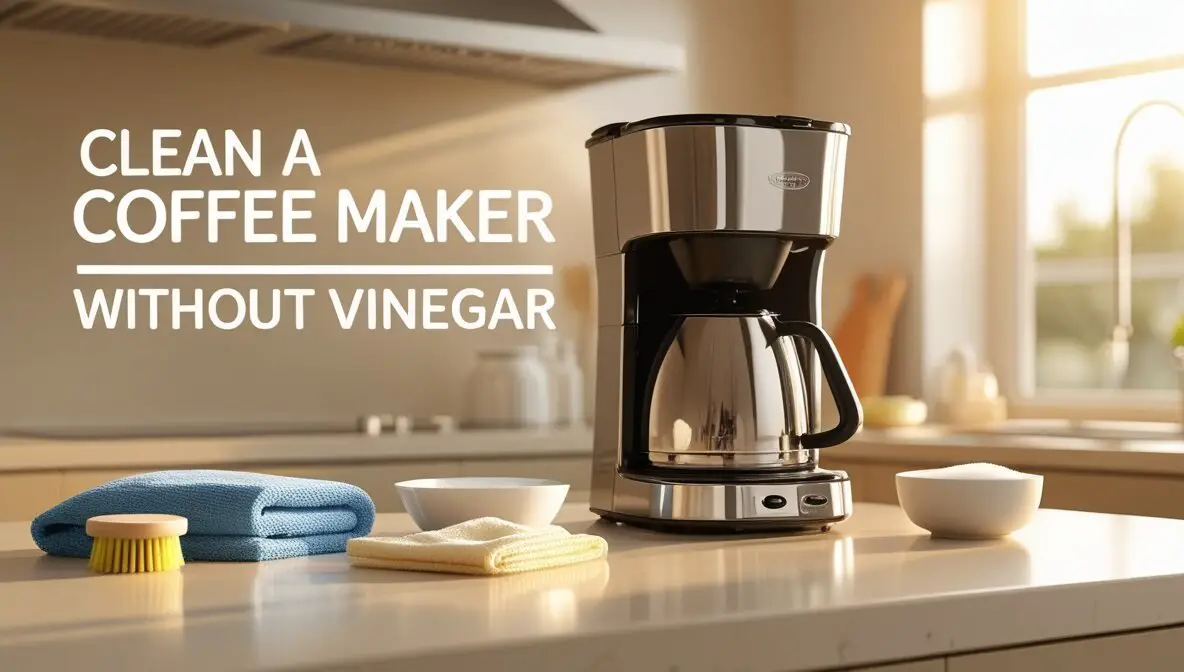Tired of the vinegar smell lingering after cleaning your coffee maker? You’re not alone! While vinegar is a popular cleaning solution, its strong odor and potential to harm certain materials can be a downside. The good news? There are safe, effective, and vinegar-free alternatives that leave your coffee machine spotless and fresh-smelling.
In this article, we’ll explore the best ways to clean your coffee maker without using vinegar. From using baking soda to natural cleaning methods, these solutions are gentler on your coffee pot, environmentally friendly, and free of pungent odors. Say goodbye to vinegar fumes and hello to a cleaner, fresher coffee machine!

Why Avoid Clean Your Coffee Maker With Vinegar?
While vinegar is often touted as an effective cleaning solution, it’s not always the best choice for your coffee maker. Here’s why you might want to skip using vinegar to clean your beloved machine:
Potential Damage to Materials
Vinegar, including white vinegar and apple cider vinegar, is acidic and can degrade certain materials in your coffee maker over time. It can damage rubber seals, corrode plastic parts, and compromise the lifespan of your machine. Opting for a method that avoids vinegar ensures the internal components remain intact and functioning properly.
Lingering Unpleasant Odor
The strong smell of vinegar often lingers in the coffee maker even after multiple rinses. This odor can affect the taste and aroma of your coffee, making subsequent brews less enjoyable. If you love your coffee’s pure flavor, a clean coffee maker with no vinegar is the way to go.
Environmental Concerns
While vinegar is considered environmentally friendly in small quantities, frequent use to clean your coffee maker may lead to overuse and waste. Choosing alternative methods reduces reliance on vinegar to clean your coffee maker, making your routine more sustainable.
For a fresher, safer, and odor-free alternative, ditch the vinegar and explore more effective ways to clean your coffee machine.
How to clean your coffee maker without Vinegar
If you want to clean your coffee maker without vinegar, here are some effective, natural, and commercial alternatives that ensure your machine stays spotless and your coffee tastes its best.
1. Baking Soda and Water Solution
Method:
- Mix 1 tablespoon of baking soda with 1 cup of warm water to create a cleaning solution.
- Pour the mixture into the water reservoir of your coffee maker.
- Run a brewing cycle with the solution to allow it to clean the internal parts of your machine.
- Follow up with two brewing cycles using clean water to rinse thoroughly.
Tips:
- Remove and clean detachable parts like the coffee pot, filter basket, and drip tray with dish soap and warm water.
- A baking soda solution is gentle and safe, making it a great way to clean a coffee maker while preserving its materials.
2. Commercial Coffee Machine Cleaners
Method:
- Choose an eco-friendly cleaning agent specifically designed for coffee machines.
- Follow the instructions on the packaging, usually involving adding the cleaner to the water reservoir and running a brewing cycle.
- Complete the process by running a couple of cycles with clean water to remove any residue.
Tips:
- Opt for non-toxic and biodegradable products to keep your coffee maker safe and eco-friendly.
- These cleaners are formulated to remove mineral buildup and oils without leaving an aftertaste, ensuring the taste of your coffee stays pure.
Caution:
- Always adhere to the manufacturer’s guidelines to avoid damage to your coffee maker.
3. Citric Acid Powder
Method:
- Dissolve 1–2 tablespoons of citric acid powder in 1 liter of warm water to create a natural cleaning solution.
- Pour the solution into the water reservoir and run a complete brewing cycle.
- Follow with two cycles using only clean water to rinse thoroughly.
Tips:
- Citric acid is an excellent cleaning agent that removes limescale and mineral deposits during a deep clean.
- Avoid using too much citric acid to prevent a sour aftertaste.
4. White Grapefruit Seed Extract
Method:
- Mix 10–15 drops of grapefruit seed extract with 2 cups of warm water to create a powerful cleaning solution.
- Add the solution to the water reservoir and run a brewing cycle.
- Follow with a couple of brewing cycles using clean water to rinse the machine.
Tips:
- Dilute the extract properly to ensure safety and effectiveness.
- Grapefruit seed extract acts as a natural disinfectant, keeping your coffee maker hygienic and odor-free.
Preventative Measures to Keep Your Coffee Maker in Top Shape
Keeping your coffee maker clean isn’t just about the occasional deep clean—it’s about adopting simple habits to maintain its performance and ensure your coffee tastes great every day. Here are some preventative measures to help:
1. Regular Cleaning
Clean your coffee maker regularly to prevent mineral deposits, coffee oil buildup, and bacteria from accumulating inside the machine.
- After every use, wash the coffee pot, filter basket, and other detachable parts with warm water and dish soap.
- Wipe down the exterior and control panel to keep your coffee maker spotless.
By making regular cleaning a habit, you can extend your machine’s life and ensure consistent coffee quality.
2. Using Filtered Water
Switching to filtered water can significantly reduce the buildup of mineral deposits inside your coffee maker.
- Filtered water is free from heavy minerals like calcium and magnesium, which contribute to limescale formation.
- By minimizing these deposits, you’ll reduce the need for frequent descaling and keep your machine running smoothly.
Filtered water not only protects your coffee maker but also enhances the flavor of your coffee.
3. Descaling Regularly (Even Without Vinegar)
Descaling is crucial for maintaining the optimal performance of your coffee maker, especially if you live in an area with hard water.
- Use natural descaling solutions like citric acid powder or commercial products designed for coffee machines.
- Descale every 1–3 months, depending on how often you use your coffee maker and the hardness of your water.
Regular descaling prevents clogs, ensures consistent water flow, and keeps your coffee tasting fresh without any unpleasant aftertastes.
Conclusion: How to Clean a Coffee Maker Without Vinegar
Finding the best method for keeping your coffee maker spotless and odor-free doesn’t have to include vinegar. With these alternative approaches, you can maintain your machine effectively and enjoy fresh, delicious coffee every time. Learning how to clean a coffee maker without vinegar opens the door to gentler options like using baking soda, citric acid, or eco-friendly cleaning agents that are safe for your coffee machine.
By exploring these ways to clean a coffee maker, you can protect your machine from damage, avoid lingering odors, and ensure optimal performance. Regular care and attention keep your coffee maker running smoothly and your coffee tasting its best. Cheers to a clean coffee pot and a perfect brew!
Can I use baking soda to clean my coffee maker?
Yes! Baking soda is an excellent natural cleaner. Mix 1 tablespoon of baking soda with warm water, run it through your coffee maker, and follow with a rinse cycle using clean water to remove any residue.
What are some natural alternatives to vinegar for cleaning a coffee maker?
Natural alternatives include baking soda, lemon juice, citric acid powder, and grapefruit seed extract. These options effectively remove buildup and odors without leaving a strong smell.
How often should I clean my coffee maker?
You should clean your coffee maker regularly. Rinse detachable parts after each use, and deep clean the machine monthly to prevent mineral buildup and maintain its performance.
Can I use commercial cleaners instead of vinegar?
Yes! Commercial coffee machine cleaners are specially designed to clean your coffee maker. Look for eco-friendly, non-toxic options and follow the manufacturer’s instructions for the best results.
Do I need to descale my coffee maker even without vinegar?
Yes, descaling is essential to remove mineral deposits, especially if you live in a hard water area. Use citric acid powder or commercial descaling solutions for effective results.
How do I remove coffee stains from the coffee pot?
Add a mix of baking soda and water to the coffee pot, scrub gently, and rinse thoroughly. This method removes stubborn stains and leaves the pot sparkling clean.
Can I use dish soap to clean my coffee maker?
Yes, dish soap can be used to clean detachable parts like the coffee pot, filter basket, and drip tray. However, avoid running dish soap through the machine itself.

Anamika is a passionate writer for Eco365Store.com, specializing in topics that inspire a cleaner, greener world. With expertise in home cleaning, recycling, and eco-friendly solutions, she crafts engaging and informative articles that help readers adopt sustainable practices in their daily lives.

